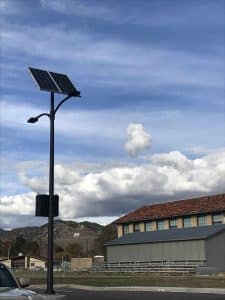What is the Best Solar Panel Technology (For Lighting Needs)?Posted by in Solar FAQs.
You're probably aware that Greenshine is a company that specializes in solar lighting. You're also probably aware that solar lighting uses solar panels. If you're not aware of these facts, welcome to our site! For the remaining crowd, or for those who we have piqued interest, we've developed a comprehensive guide of solar technology and pinpointed the ones that are best for parking lot lighting and similar applications. Stick around for this 6 minute read and you'll learn the in-and-outs of solar panels. There may be technologies on here you haven't heard of, so there may be more learning opportunities ahead. Prepare thy noggins, here's a lesson in the exciting world of photovoltaics. What is the Best Solar Panel Technology for Lighting?There are many, many types of solar technologies, so it's important to understand what's out there, what's new, what's not, what's hot. Here's where we dive into several different technologies, some very high-tech, to understand what gets the best ding for your dollar. The jargon can get a little thick from here on out, so we've slimmed it down to understand the essentials when it comes to photovoltaics. The biggest factors come down to the materials they're constructed with (and their environmental impact), cost, and efficiency. Bifacial solar cellsThere's not much behind the name with bifacial solar cells--it's a solar cell with two faces. Since solar cells have come down in price across the board with several different technologies, bifacial has seen more popularity in the past decade for companies. The energy yield for bifacial cells, however, nets about 10% more power than single-panel cells, and so the price investment doesn't yield much of a return on power. Plus, there's about a 5% market share in comparison to more commercially available technologies. A typical optimal solar panel angling is 45 degrees south, and so tilting a bifacial panel would deny the opposing side exposure to the sun. Basically, you pay for two panels but don't get the efficiency. We might see higher application for bifacial solar panels in the future, but as for today's applications it still isn't the best solar panel technology for lighting. Cadmium Telluride Solar Cell
Thin-Film Solar CellLabeled as a "second-generation" solar cell, thin film solar cells use different semiconductor materials (other than just silicon). As its name suggests, it's much thinner than crystalline silicon cells, making it highly popular for rooftop installations because of its pliability and portability. Its biggest drawback is that it isn't very efficient in comparison to more common market technologies (about a third compared to standards) and the cost is typically 5 times higher. Current market trends show that a lot of materials suppliers for thin film have gone out of business, suggesting that thin film might be gone soon or too scarce to be marketable. Polycrystalline Solar CellA "poly" cell is manufactured from what's called the Siemens process in order to form silicon into a solar cell. Poly cells consist of small crystals (thus poly) that result in a metallic look. It's a highly-used technology and one of the most commercially available types of solar cells. However, it's a less-efficient semiconductor than other technologies. Polycrystalline is typically used in home applications and for people or companies that just want something cheap enough to use in their own projects. Skip it. Perovskite Solar Cells
Monocrystalline Solar CellMonocrystalline technology is a tried-and-true form of silicon-based solar cell manufacturing. The Czochralski process behind manufacturing the cell takes longer than the Siemens process and is more wasteful of silicon, but the efficiency rates are considerably higher than thin film and polycrystalline cells averaging about 25% efficiency. Since the Czochralski process has been highly researched and developed over the past decades, the result is a relatively cheap method of solar cells that can be housed in lightweight encapsulations--perfect for installing on top of solar light poles. That's the best solar panel technology for solar lights. These panels are rated to last about 25 years, so you can be certain to get your money's worth when it comes to these panels. At Greenshine, we have a combined 30 years of experience under one roof. We've got the know-how to find the best technology at the best prices so you don't break the bank. Learn how we've helped thousands of businesses and cities save money through the power of renewable energy. Invest the money saved from getting the best solar lighting tech on the market into developing your business even further. You can thank us later. Image Credit: Alchemist-hp (www.pse-mendelejew.de) - Own work, CC BY-SA 3.0, CdTe Perovksite By Rob Lavinsky, iRocks.com – CC-BY-SA-3.0, CC BY-SA 3.0, Perovskite
Solar FAQs
|
ArchivesNo Archives Categories
Want More Info? |
LATEST NEWS & ARTICLES

 A CdTe cell is an interesting technology that uses cadmium telluride as its semiconductor. It's actually cheaper than crystalline silicon for solar panel development and carries the smallest carbon footprint in comparison to other technologies, but the drawback is that cadmium is a highly toxic chemical that isn't as abundant as silicon. With a legitimately questionable impact on the environment, CdTe cells are best reserved for larger solar panel arrays (such as massive solar farms) instead of poles for city and business lighting.
A CdTe cell is an interesting technology that uses cadmium telluride as its semiconductor. It's actually cheaper than crystalline silicon for solar panel development and carries the smallest carbon footprint in comparison to other technologies, but the drawback is that cadmium is a highly toxic chemical that isn't as abundant as silicon. With a legitimately questionable impact on the environment, CdTe cells are best reserved for larger solar panel arrays (such as massive solar farms) instead of poles for city and business lighting. Perovskite cells are gaining steam in the solar cell arena, but the technology has really only begun to compete with more traditional solar cells. Instead of silicon, the solar cells are manufactured with perovskite, a mineral found abundantly in the Earth's mantle. While the technology is rapidly gaining popularity in use for solar power applications, it hasn't been often used for
Perovskite cells are gaining steam in the solar cell arena, but the technology has really only begun to compete with more traditional solar cells. Instead of silicon, the solar cells are manufactured with perovskite, a mineral found abundantly in the Earth's mantle. While the technology is rapidly gaining popularity in use for solar power applications, it hasn't been often used for 